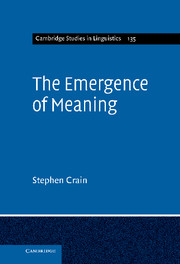Book contents
5 - How something can be bothpositive and negative
Published online by Cambridge University Press: 05 November 2012
Summary
English and Mandarin Chinese are typologically distinct languages, yet they share several core linguistic properties. These core properties govern the assignment of interpretations to logical expressions, individually and in combination. For example, both English and Mandarin have downward-entailing expressions. Downward-entailing expressions are important in teasing apart the alternative accounts of language acquisition, because such expressions tie together clusters of linguistic properties, including fixing the interpretation of disjunction. Both English and Mandarin possess logical expressions that are similar in meaning to the corresponding expressions in logic, including the inclusive-or interpretation of disjunction, to cite just one example. The inclusive-or interpretation of disjunction serves as the basic meaning of disjunction in classical logic and forms the basis for the logical entailments in de Morgan’s laws. The previous chapter reviewed several experimental investigations of children’s knowledge of the syntactic and semantic constraints on the interpretation of disjunction words (English or and Mandarin huozhe). The findings from these investigations demonstrated that, in responding to sentences with disjunction, children acquiring English and Mandarin (and Japanese) initially assigned interpretations that coincide with the laws of logic.
If downward entailment is an innate property of human languages, then we would expect downward-entailing expressions to also manifest another of its characteristic properties, both within and across languages, namely the licensing of negative polarity expressions such as any, ever, and at all, and their counterparts in other languages. Although the licensing of negative polarity items and the conjunctive entailment of disjunction appear to be unrelated, we observed in Chapter 1 that these linguistic phenomena are really variations on a theme, which explains why they are both associated with the class of downward-entailing expressions. The prediction that these expressions form a natural class in human languages has been confirmed, both within and across languages. In the present chapter, we report the findings of experimental investigations of children’s competence in producing and understanding polarity-sensitive items. As noted, polarity-sensitive items can be partitioned into negative polarity items, such as English any, and positive polarity items, such as English some. We review what we have found out from experimental investigations of the acquisition of both kinds of polarity-sensitive items. We begin with a brief discussion of their linguistic behavior in adult languages.
Information
- Type
- Chapter
- Information
- The Emergence of Meaning , pp. 199 - 223Publisher: Cambridge University PressPrint publication year: 2012
